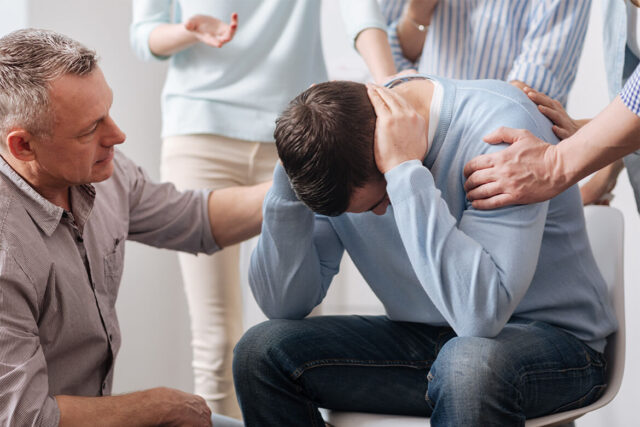
Anxiety Types You Shouldn’t Ignore
Understanding Anxiety: The Most Common Types Explained
Anxiety has a way of slipping into your day or hijacking your thoughts before you even notice it showing up… tightness in your stomach, a mind that won’t slow down, or a feeling you can’t quite explain. It becomes easy to label everything as “just my anxiety,” even when you’re not fully sure what’s causing it.
You know something’s off. You feel it physically, emotionally, mentally but the source feels fuzzy, maybe even completely undetectable. If that sounds like you, you’re far from alone. Anxiety isn’t just one single experience; it has different flavors, different triggers, and different ways of hijacking your mind and body.
Understanding the type of anxiety you’re dealing with can help you feel less overwhelmed and more in control. What if I told you that once you can name it you can actually respond to it… instead of feeling like it’s running the show.
Let’s walk through the major types of anxiety, how each might show up in your day-to-day life, and how to regulate in the moment when it hits.
1. Generalized Anxiety (GAD): The Constant “What If”
GAD isn’t loud or dramatic, it’s subtle, steady, and persistent. It’s the type of anxiety that makes you worry about things that haven’t happened yet… and may never happen.
It may feel like:
- A constant sense of dread or unease.
- Overthinking every scenario.
- Feeling tense for “no reason.”
- A mind that just won’t shut off.
Maybe you’ve had moments where you think, “Why am I stressing about this? It doesn’t even make sense.” That’s GAD’s signature move… making everything feel like it could go wrong.
Tips to Regulate :
- Name the worry: Say, “This is my anxiety talking right now.” That simple separation helps your nervous system calm down.
- Take a breath: Inhale 5 seconds, hold 5, exhale 5.
- Ask yourself: “Is this a problem I need to solve, or a fear I need to soothe?”Most GAD spirals fall into the second category. Which means pause and let the wave pass instead of trying to solve it.
2. Social Anxiety: The Inner Critic Turned All the Way Up
Some people think of social anxiety as just being shy, but it’s deeper than that. It’s the fear of being judged, disliked, or “messing up” socially, paired with the frustration of wishing you could relax, be yourself, and connect the way you want to.
It may look like:
- Replaying conversations long after they’re over.
- Avoiding phone calls, events, or speaking up.
- Feeling physically sick before social interactions.
- Believing others are noticing every tiny thing you do “wrong.”
If you’ve ever walked away from a conversation thinking, “They probably think I’m weird,” or avoided an event altogether due to the reasons above, social anxiety has likely been in the driver’s seat.
Tips to Regulate:
- Shift the focus: Instead of “How am I coming across?” try “What’s one thing I’m curious about right now?” Curiosity softens self-consciousness.
- Shift your attention outward: Scan the room for something to focus on other than the internal dialogue that’s focused on perceived judgement.
- Challenge the assumption: Ask yourself, “What evidence do I have that they’re judging me?” Spoiler alert: there’s almost always none.

3. Panic Anxiety: When Your Body Hits the Alarm Button
Panic anxiety is intense and fast. It’s like your body slams on the gas pedal before your mind realizes the light turned green.
It can feel like:
- A racing heart
- Shortness of breath
- Chest tightness
- Feeling like you’re losing control
- Feeling like something terrible is about to happen
- You may think, “Something’s not right. Why am I losing control of my body?”
Panic is your nervous system misunderstanding a stressor as a threat. This is your fight-or-flight system kicking in before your brain can catch up.
Tips to Regulate:
- Ground your body first: Sit down, plant your feet, press your hands gently together.
- Sip cold water or run cold water on your wrist: This signals safety to your nervous system.
- Lengthen the exhale : Inhale for 4, hold for 6, exhale for 8. Longer exhales deactivate panic.
4. Phobia-Based Anxiety: The Fear That Feels Bigger Than You
This is an intense fear of a specific thing; flying, driving, needles, insects, elevators, storms… anything your brain has labeled as “dangerous.” You might think, “I know some people do this everyday and come out okay, but just thinking about it makes me tense up.” That right there is phobia anxiety, your logic says one thing but your body says another.
Phobia anxiety often comes with anticipatory stress; the dread doesn’t just show up in the moment, it builds in the hours or days leading up to it. You might find yourself avoiding certain places, activities, or even conversations, all to prevent the panic from happening. People often dismiss phobias as “just a quirk” or “irrational fear,” but the physical and emotional reactions are very real. Your body doesn’t negotiate with logic… it reacts first, fast, and fiercely.
Tips to Regulate:
- Gradual exposure : take micro-steps to exposure, if it’s flying, visualize yourself sitting on a plane before take off, then watch a video of a plane first; if it’s spiders, look at a photo for 30 seconds. And regulating yourself in the moment while taking small steps, this will gradually teach your nervous system to feel safe.
- Have a recovery plan just incase panic spikes – having a plan gives you comfort that you’ll have something to lean on if you were to panic.
- Use a grounding object: (stone, bracelet, scent) to bring you back to safety cues.
5. Health Anxiety: When Every Sensation Feels Like a Warning
Health anxiety shows up as constant worry that something might be wrong with your body. You notice every twinge, pulse, or ache and your mind jumps to worst-case scenarios: “What if this is serious?”
Whether this is just from the anticipation of something being wrong or based on a legitimate diagnosed concern, anxiety can amplify it, making your body feel like danger is immediate. The key is learning to manage fear without ignoring real issues.
Tips to Regulate :
- Limit symptom-checking and googling : this creates rumination of the negative.
- Validate, then act: If a symptom is new, worsening, or unusual, schedule a check-up.
- Shift focus from “what if” to “what now”: Ask yourself, “What can I actually do right now?” Anything beyond that is worry, not action.
6. Situational Anxiety: Stress Triggered by Specific Life Events
The type of anxiety that shows up in response to a specific situation or event… think job interviews, public speaking, exams, or even a big life change. It’s that knot in your stomach, racing thoughts, or sweaty palms that flare up right before or during a moment you know matters.
Let’s be real, you brushed off your own anxiety because “it’s normal.” It’s not constant, and it’s not about overthinking everything all the time. But it still matters. And the tricky part is… Sometimes the fear sneaks in early, hours or days before the event, and suddenly a normal situation feels more stressful than it really is.
Whether it’s…
- Starting a new job
- Moving
- Financial decisions
- Relationship changes
- A big upcoming responsibility
This type of anxiety is tied to something real, and the emotional reaction can still feel overwhelming.
Tips to Regulate:
- Break the situation into smaller pieces : Overwhelm decreases when tasks feel more manageable.
- Journal : writing is a form of release, dump every fear onto paper so your mind doesn’t have to hold it.
- Remind yourself: “I don’t have to be perfect, I just have to do my best.”
Here’s where you take back the narrative…
When you can recognize what kind of anxiety you’re experiencing, you can finally start responding with the right tools instead of feeling defeated or confused.
And maybe, just maybe… This is why therapy has been on your mind lately. You’ve had moments where you thought about talking to someone, but life got busy, or you weren’t sure where to start, or perhaps a part of you hoped things would just “settle down.” This is your reminder to prioritize you.
Therapy helps you understand where your anxiety comes from, how it shows up in your body, and how to stop feeling controlled by it. You don’t have to figure this out alone. You deserve support, clarity, and a sense of peace, and therapy is one of the safest places to find exactly that.
Please be advised that the information provided in this blog does not serve as a clinical diagnosis for you. Please seek mental health support for any direct diagnosis needs.
Learn More

The Benefit of Self Compassion in Anxiety
How self-compassion assists in overcoming anxiety
Anxiety is one of the most common emotional experiences in the United States right now. We want you to know that it is ok to sometimes be anxious. If anxiety is starting to creep into all parts of your life, we are here for that too! When you have anxiety issues, our anxious emotions tend to create fear, worries, and overwhelm. Additionally, these feelings can fill all parts of our life including our relationships, work performance, and overall health. Also, it should not go unnoticed that anxiety struggles can also create a secondary experience of deep inner criticism. This criticism comes out in many ways. One of the most common is that this inner criticism can come out as inaccurate beliefs that you ‘should’ be a lot of things. “I should be strong.” “I should be able to handle this by now.” “I should be more like others.”
Inner Criticism will increase your Anxiety
If you have been in therapy, you have probably heard from your therapist that allowing inner thoughts that lead with the ‘should’ word will cause increased emotional distress. This is true! ‘Shoulding’ ourselves causes self criticism and low self esteem. Today, we want to encourage you to begin applying self-compassion as one of your approaches to helping yourself manage anxious emotions.
Using self compassion helps to move away from feeling shame in our emotions. This approach actually works very well when you are managing anxiousness. Rather than the internal criticism, it allows emotional space to consider how to best approach the emotion. There are a number of benefits to using self compassion, especially when living with anxiety. Here are a few….
Why self-compassion helps with anxiety
Improves emotional regulation
Self-compassion can help people be more aware of their emotions and regulate them. This works because compassion depersonalizes the anxiety allowing for you to apply skills to “work” on your anxiety.
Increases Confidence
Once you are able to be compassionate to yourself with your anxiousness, another change comes. You are no longer blaming your entire self for being anxious and thus allowing confident feelings to be recognized in other parts of who you are.
Reduces shame and guilt
Self-compassion teaches us acceptance in our entire selves. Not to mention, once you learn how to lean into self compassion, you will naturally feel less shame and guilt.
Tips on how to practice self-compassion
Be kind to yourself
Validate your emotions and offer yourself patience. When struggling, talk to yourself as if you were talking to a close friend or family member. Do not minimize or belittle yourself when you are struggling with a feeling or emotion in your day.
Practice mindfulness
This skill helps us to slow down the rapid fire of thoughts and adjust if they are unhealthy. Focus on your breathing and gently acknowledge anxious thoughts. Daily mindfulness practice is shown to increase emotional wellness.
Treat yourself well
Are you giving yourself time to rest and recover? Or possibly you may need an activity that is soothing to your body. Take a bath, go dancing, stretch for 30 minutes, or listen to music.
Practice Daily Affirmations
Remind yourself of the things you are appreciating of yourself. What ways have you made yourself proud? What things have you accomplished, big or small, that pleases you. Remember that you’re capable of changing how you feel and that your self-worth comes from within!

Self-Compassion is an Antidote to Anxious Moments
Above all else, remember that your care and love of yourself helps to extinguish the powerful hold anxious emotions can have on you. Your therapist will work with you on additional strategies as well, but these are tips and tricks that you yourself can use every day to support your emotions that much more!
Learn More

7 signs of anxiety in your life
7 signs of an anxiety disorder that suggest you should visit a professional counselor.
Learn More
What is Obsessive Compulsive Disorder?
Understanding OCD: A Brief Tutorial About the Body’s Faulty Warning System
Written by: Sarah Groff, LCMHCS, PhD
When many people think of obsessive-compulsive disorder (OCD), they often picture someone like Jack Nicholson’s character in the opening scenes of As Good as It Gets. He is repeatedly washing his hands with scalding water and multiple bars of soap. Although this represents one type of OCD (contamination type), it is certainly not the only presentation of this condition. Nor is it simply about someone being a “germaphobe” or a “clean freak.” While our culture often throws around the term OCD to refer to someone who likes a clean home or workspace or who is particularly organized or planful, the term is far more extensive than this. In this article I will provide a brief description of OCD and some of its many presentations. We will also give an explanation for why the body responds this way to certain situations. I will conclude with a few suggestions for coping skills and treatment.
While our culture often throws around the term OCD to refer to someone who likes a clean home or workspace or who is particularly organized or planful, the term is far more extensive than this. In this article I will provide a brief description of OCD and some of its many presentations. We will also give an explanation for why the body responds this way to certain situations. I will conclude with a few suggestions for coping skills and treatment.
What is OCD?
According to the Diagnostic and Statistical Manual (DSM-5-TR), OCD is a disorder in which both obsessions and compulsions are present. The obsessions are persistent anxious or intrusive thoughts. The individual tries to alleviate this by engaging in various types of compulsions designed to reduce the distress associated with these fears.
Examples of obsessions include fear of harm (to oneself or another), contamination, or things being uniform (otherwise known as symmetry). Examples of compulsions include, but are not limited to, hand washing, double checking, looping thoughts, assurance seeking, avoidance, praying, or counting. To be diagnosed with OCD, these symptoms must not only be present, but must also cause substantial distress and be significantly time consuming. They also cannot be explained by some other medical or mental health condition.
Types of OCD
This list is not meant to be an exhaustive one of OCD presentations; however, these are some of the more common types:
- Harm OCD (Extreme fear of harming oneself or harming another individual. Individuals may fear they are suicidal even when they are not or that they will harm someone else even though they have no ill will toward another person.)
- Sexual Orientation OCD (Obsessions about one’s sexuality)
- Pedophilia OCD (to be differentiated from pedophilia) (This type of OCD can be particularly distressing to individuals because their obsessions do not reflect their desires.)
- Relationship OCD (Inability to tolerate uncertainty of intimate relationships, which leads to incessant questioning of the “rightness” of the relationship.)
- “Just Right” OCD (Not necessarily a specific fear, but rather a sense that something “just isn’t right” when not done a certain way.)
- Contamination OCD (Fear of getting sick or coming into contact with germs)
- Pure-O OCD (This type is somewhat debated, but is used to describe those individuals who do not exhibit visible compulsions; however, compulsions are still present, such as looping or ruminating thoughts.)
- Scrupulosity/Religious OCD (Obsessions about violating moral, ethical, or religious beliefs)
The Brain’s Faulty Warning System
Oftentimes, OCD is referred to as the brain’s faulty warning system because it perceives a threat when there is none. Although anxie

ty and OCD can be precipitated by an actual event, such as a car accident, this is not always the case. More often than not, the obsessive thoughts are an endless stream of “what if” scenarios that never happen. Biologically, the body is designed to keep us safe and it will go to great lengths to do so. In the brain of someone with OCD, it will engage in a cycle of obsessions and compulsions as a way of maintaining hypervigilance, believing this is what keeps the body safe. The unconscious rationale is that “As long as I continue to think about this thing and keep it at the forefront of my mind, then I won’t let my guard down and be hurt.” Because these thoughts are so distressing, however, the body also engages in compulsive behaviors to temporarily alleviate the stress, worry, and fear that come with them.
The driver of this whole process is UNCERTAINTY. If the body detects uncertainty, whether false or actual, it will kick the cycle into gear. As mentioned above, for the person struggling with OCD, this can be an extremely debilitating process. The key to OCD recovery is breaking the obsessive-compulsive cycle and going to solution.
Treatment for OCD
There are a variety of effective approaches to treating OCD, including medication, which is necessary for many individuals. With appropriate medication and therapeutic interventions relief can be found. Those interventions include Cognitive Behavioral Therapy (CBT) and Exposure and Response Prevention (ERP). The primary goal in my work with clients who struggle with OCD is to teach them why their body is responding the way it is, to recognize intrusive thoughts as they arise, and to learn to reassure themselves that they are safe. This involves a client thanking the body for keeping him/her safe and then identifying solutions to do this without the “help” of OCD.
If you or someone who know is struggling with OCD, therapy is an excellent tool for recovery. Please feel free to reach out to our office to schedule a session with one of our many trained and compassionate providers.
Sarah Groff, LCMHCS, PhD is a counselor with Miracles Counseling Centers, Mooresville. She is experienced in supporting blended family systems, and a wide variety of issues. These include grief and loss, marriage, divorce, blended families, infertility, parenting, adoption and foster care, depression, anxiety, and work-related stress. She is a passionate advocate in the field of mental health, and a compassionate, insightful support to her clients.
Learn More

What does high functioning anxiety or depression look like?
You may have heard people around you using the term “high-functioning” to describe themselves and their mental health. Phrases such as high-functioning anxiety and high-functioning depression are being used more and more, but what do they mean?
High-functioning anxiety and depression are not technically clinical diagnoses because they are not listed in the Diagnostic and Statistical Manual of Mental Disorders (DSM-5), a handbook used by mental health professionals. However, many practitioners and researchers recognize that people can experience symptoms of anxiety or depression and continue to be highly functioning, productive individuals. Those who have high functioning anxiety or depression may not appear to struggle with it on the surface, despite experiencing symptoms internally. To others, they may seem to have it all together or go about their days as they normally would.
What Does High-Functioning Anxiety Look Like?
People with high-functioning anxiety may experience symptoms of anxiety disorders, such as excessive worrying most days, feelings of restlessness, fatigue, difficulty concentrating, irritability, muscle tension, or trouble sleeping. However, these symptoms do not cause significant problems across areas of their lives and do not inhibit daily functioning. Some common characteristics of individuals with high-functioning anxiety include:
- High-achieving, with a fear of failure
- Extremely organized & detail-oriented
- Engages in nervous habits, such as nail-biting, hair twirling, lip biting, leg shaking, etc.
- Perfectionist with a harsh inner critic
- Active & needs to keep “doing,” finding it hard to relax
- Appears calm on the outside, but may have racing thoughts
- People pleaser who has a hard time saying no
- Procrastinates when stressed
- Talks a lot or has nervous chatter
- Overthinks and overanalyzes everything
- Difficulty expressing emotions
- Need for repetitions and reassurance
- Tendency to dwell on the negative
What Does High-Functioning Depression Look Like?
Similarly to high functioning anxiety, individuals with high-functioning depression may not meet the criteria for a clinical diagnosis of depression, but are able to function normally most of the time. Thus, their depression is often not clear to others or themselves. Typical symptoms of depression would include persistent sad mood, feelings of hopelessness, worthlessness, and/or guilt, loss of interest in hobbies or activities, fatigue, irritability, trouble sleeping, changes in appetite or weight, or thoughts of death or suicide. The following may be characteristic of an individual with high-functioning depression:
- Feeling a little down most of the time
- Poor self-esteem
- Difficulty making decisions
- Low energy and motivation
- Performs well at school or work, but has difficulty focusing on tasks
- Crying a lot without any concrete reason
- Forcing oneself to engage in social activities when they’d rather withdraw
- Feeling overwhelmed
- Feeling lonely
The Role of Stress
Before determining whether or not you have high-functioning anxiety or depression, it is important to first consider current stressors and evaluate their impact on your life. April is National Stress Awareness Month. We all experience stress in response to challenging circumstances and some times are more stressful than others. This is our body’s normal response. However, if these symptoms persist well beyond a stressful event or are consistent and unrelated to specific stressors, you may be experiencing high-functioning anxiety or depression.
This truly highlights the importance of good mental health care and scheduling check in’s with a mental health therapist. The opportunity for building insight and awareness of our emotional loads and the management of that load is done best with the help and insight of a professional who can guide you through this. Everyone should consider seeing a therapist! When you are ready to do so, you can visit our therapist’s page to find a clinician who fits you best.
Sources: nimh.nih.gov, rtor.org, psyccentral.com, waldenu.edu, health.usnews.com, washingtonpost.com
Learn More
What to know about Obsessive Compulsive Disorder now
Have you wondered what truly qualifies as having Obsessive Compulsive Disorder? We hear this phrase very commonly now, and many people like to make light of their selves or routines by saying “I’m OCD,” but are they actually? It’s important to clear up any misconceptions regarding this so you can know when you actually need to seek help. Early intervention is critical for your health and to live a full life. Read on below to fully understand what having OCD means.
What is Obsessive Compulsive Disorder or OCD?
Obsessive Compulsive Disorder (OCD) is a common mental health condition characterized by repetitive, unwanted thoughts (obsessions) and excessive urges to engage in behaviors related to these thoughts (compulsions). OCD affects both children and adults and is typically diagnosed by late adolescence or early adulthood. OCD can be a very life limiting disorder, but with proper treatment a health and fulfilling life can be achieved.
What are the Symptoms of OCD?
- Obsessions: These are unwanted, disturbing thoughts, images, or urges that won’t go away, despite causing severe distress or anxiety. Individuals with OCD know these thoughts are irrational, but feel like they have no control over them. Obsessions are typically accompanied by feelings of fear, disgust, or doubt.
- Compulsions: These are repetitive behaviors or rituals intended to counteract the obsessions or make them go away. Individuals with OCD know that these behaviors are not realistic, but they feel like they must do them to relieve the anxiety caused by obsessions or prevent something bad from happening. Compulsions do not bring pleasure and provide only temporary relief. They are time consuming and get in the way of daily activities.
How is OCD Diagnosed?
Although you may hear people say that they have OCD because they occasionally experience an impulsive thought or compulsive behavior, OCD is an ongoing cycle that severely interferes with normal, daily functioning. Lightly using the phrase “I have OCD” can bring misconceptions to the significant impact and struggles of what having Obsessive Compulsive Disorder is like. There are very specific criteria that must be met in order to receive an OCD diagnosis. To be diagnosed with OCD, you must have:
- Obsessions, compulsions, or both
- An inability to control your obsessions (thoughts) and compulsions (behaviors), even when you recognize that they are irrational
- Obsessions and compulsions that last at least an hour each day and cause significant problems with work, relationships, or other parts of life
- No gain of pleasure from compulsions aside from a brief relief from anxiety caused by the obsessions
What are the Subtypes of OCD?
Though there are many types of OCD, individuals’ obsessions and compulsions tend to fall into one of the following five main subtypes.
- Contamination Obsessions & Washing/Cleaning Compulsions- Individuals with this subtype fear discomfort related to dirt & contamination and will engage in excessive washing or cleaning to relieve their stress. (e.g. Washing your hands repeatedly for hours after touching a door knob)
- Harm Obsessions & Checking Compulsions- Individuals with this subtype worry about possible harm to themselves or others and engage in constant checking rituals to relieve their distress. (e.g. Worrying about your house burning down and repeatedly driving by your house to make sure there is no fire; Worrying that you are increasing the likelihood of something bad happening just by thinking about it)
- Symmetry Obsessions & Ordering/Arranging/Counting Compulsions- This subtype involves the urge to arrange and rearrange things to prevent feelings of discomfort from things not feeling “right” or symmetrical (e.g. Wanting to write the exact same number of words in each line on a page). Sometimes these compulsions are used to prevent potential harm or danger. (e.g. “Something bad will happen if the pillows on my bed are uneven.”)
- Hoarding- Individuals who hoard are unable to discard possessions with little value due to the fear of losing items that may be needed one day. This subtype is associated with higher depression and anxiety than other subtypes.
- Obsessions Without Visible Compulsions- Individuals with this subtype will ruminate over unwanted thoughts, particularly related to sexual, religious, or aggressive themes. Instead of engaging in compulsions, mental rituals may be used, like reciting words, counting in one’s head, or praying for relief. (e.g. Intrusive thoughts about attacking someone)
How is OCD Treated?
Treatment for OCD typically involves medication, psychotherapy, or a combination of the two. Antidepressants are the most common medications used to treat OCD, and must be prescribed by a medical doctor or psychiatrist. Cognitive Behavioral Therapy (CBT) and Exposure and Response Prevention Therapy (ERP) are also highly effective in treating OCD symptoms. CBT is focused on recognizing and changing negative thoughts that cause distress and lead to compulsive behaviors. ERP involves exposing individuals with OCD to the cause of their anxiety and prevents them from engaging in compulsions.
If some of the symptoms above sound similar to your life situation, it’s important to begin taking the steps to seek help for this. Symptoms can become worse over time and sometimes will evolve into other issues if left untreated. If you’re interested in psychotherapy for OCD, reach out to us!
Source(s): National Institute for Mental Health , International OCD Foundation, Mayo Clinic, National Association for Mental Illness, The Very Well Mind
Learn More
Coping better with Pandemic Anxiety
 In addition to an increase in the prevalence of depression, as discussed in our previous blog post, mental health professionals have also seen an increase in the prevalence of anxiety since the outbreak of the COVID-19 pandemic. Many Americans have reported that their anxiety symptoms have been significantly worse over the last year. With change on the horizon due to recent vaccine rollouts and lifted restrictions, you may find that your anxious feelings continue, or even worsen. As the future of the pandemic remains uncertain, it is normal to experience some anxiety. This is our bodies’ natural response to stress. However, sometimes we let our anxious thoughts take over, interfering with our day-to-day functioning and well-being. So, how does COVID-19 affect anxiety? And how can you manage your anxiety about COVID-19 when it seems like you’ve lost all control?
In addition to an increase in the prevalence of depression, as discussed in our previous blog post, mental health professionals have also seen an increase in the prevalence of anxiety since the outbreak of the COVID-19 pandemic. Many Americans have reported that their anxiety symptoms have been significantly worse over the last year. With change on the horizon due to recent vaccine rollouts and lifted restrictions, you may find that your anxious feelings continue, or even worsen. As the future of the pandemic remains uncertain, it is normal to experience some anxiety. This is our bodies’ natural response to stress. However, sometimes we let our anxious thoughts take over, interfering with our day-to-day functioning and well-being. So, how does COVID-19 affect anxiety? And how can you manage your anxiety about COVID-19 when it seems like you’ve lost all control?
COVID-19 and Anxiety
Many of the effects of COVID-19 that we have seen and experienced are also triggers for anxiety. During the past 18 months we have been exposed to compounding stressors that have created a continuous anxious response in many of us. We have all experienced at least one if not more of the primary triggers below:
Negative Life Events: The stress that we experience from situations such as, financial instability, job loss, sickness, death of a loved one, or trauma, can be overbearing and leave us feeling hopeless. These types of events are all triggers for anxiety. As if a global pandemic isn’t triggering enough, many of us have also experienced several of these other anxiety-producing situations at the same time.
Feeling a Loss of Control: We like to have a firm hold on the reins of our lives. It gives us a sense of stability and makes us feel safe. When we experience significant life stressors like the ones mentioned above, our feelings of security are replaced with feelings of uneasiness or restlessness. Our thoughts start to spiral toward all the “what ifs” and we feel like we’ve lost complete control over our lives. This is especially true in relation to the lack of control we feel with regard to progression of the pandemic and the restrictions that remain or are no longer in place.
Self-care is Harder to Maintain: When we feel so overwhelmed by the stress of difficult situations, it is hard to make time for self-care. This is because we give so much of our energy and thought to these stressors that we’re too tired to engage in healthy practices. Unfortunately, these are the times when we need it the most, as self-care activities often alleviate our anxious feelings.
Loneliness: Most of us have probably experienced loneliness at some point during the pandemic due to social distancing. Spending time with others tends to be a protective factor against anxiety. When we aren’t able to get the social contact we need to take our minds off stressful situations, it’s easier to allow our anxious feelings to take over.
Getting COVID-19: This one may be the most obvious trigger for anxiety during the pandemic. The ongoing fear of ourselves or a loved one testing positive for COVID-19 can lead to the onset or worsening of anxiety symptoms. Fortunately, for many, receiving the vaccine has relieved their anxious feelings. However, the vaccine has also been an additional source of anxiety for those who are apprehensive about taking it.
How Can You Cope with Anxiety as the Pandemic Improves?
Focus on the Things You Can Control: Do you feel anxious that some people and states are moving too fast to get back to normal life as the pandemic improves? On the other hand, maybe you feel like things aren’t moving fast enough and this makes you anxious. Instead of getting caught up in the aspects of the pandemic you can’t control, such as the actions of others, focus your energy and attention on what you can control and doing what’s best for you, like establishing a daily routine, getting enough sleep, eating healthy, or engaging in self-care.
Challenge Your Thoughts: We are in challenging times right now with our thoughts – the rules of what has been considered “safe” have begun to change. As this continues to happen, we will need to reassess our assumptions, beliefs, and patterns, to ensure we aren’t allowing anxiety to dominate our choices. It can be easy to allow our negative thoughts to take over when so much is changing around us. It’s still important that we learn to recognize common thought distortions, such as polarized thinking, filtering, overgeneralizations, jumping to conclusions, catastrophizing, ‘should’ statements, or emotional reasoning. When you recognize a distorted thought, stop and ask yourself, “Is this accurate?” Think about how you would respond if a friend spoke to themself that way. Consider other possible outcomes.
Practice Self-Compassion: Maybe you’ve adjusted to pandemic life and you don’t feel ready or eager to go back to the way things were as restrictions are being lifted. Are you ashamed to not be excited about reentering a world that still doesn’t feel safe to you? Maybe you’re so eager for things to go back to normal that you’re trying to do too much at once and you feel overwhelmed. Do you feel guilty because it’s now harder to juggle all of the things that you did pre-pandemic? Have some grace for yourself because times are different! Focus on doing a few of the things that make you feel more like yourself! Take time for you and go at your own pace.
Limit News Consumption: It can be tempting to keep a close watch on the news for pandemic updates, but frequent consumption can worsen anxiety by reminding us of all the things we can’t control or leaving us frustrated that pandemic restrictions are not moving at our ideal pace. Be sure to give yourself some space from the news, especially around bedtime.
Practice Gratitude and Mindfulness: Reminding yourself of things you are grateful for on a regular basis can be a great way to relieve some of your anxious feelings. Perhaps you’re feeling grateful for receiving the COVID-19 vaccine or being able to see loved ones you haven’t seen in a while. Consider keeping a gratitude journal. Mindfulness is another great way to cope with anxiety. It teaches us how to respond to our stress with awareness of what is happening in the present moment.
See a Therapist: Don’t be afraid to seek help! Your anxious feelings are valid and you are not alone in your pandemic-related anxiety. Our team of licensed therapists are familiar with the ways in which the changes surrounding COVID-19 can bring about or worsen anxiety. We are here to help you develop coping skills and show you how to use your inner strengths to manage your anxiety. We are still offering both virtual and in-person appointments in case you are anxious about meeting in-person or navigating telehealth!
Learn More



